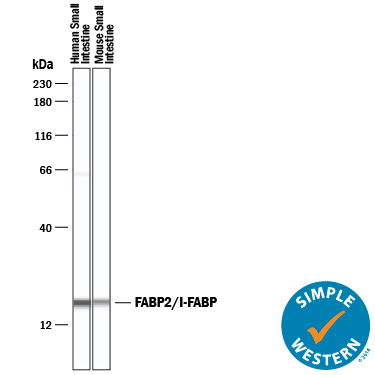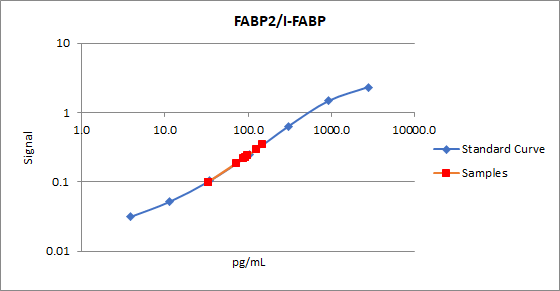Human FABP2/I-FABP Antibody Summary
Ala2-Asp132
Accession # P12104
Applications
Please Note: Optimal dilutions should be determined by each laboratory for each application. General Protocols are available in the Technical Information section on our website.
Scientific Data
 View Larger
View Larger
Detection of Human FABP2/I‑FABP by Western Blot. Western blot shows lysates of human small intestine tissue. PVDF membrane was probed with 1 µg/mL of Goat Anti-Human FABP2/I-FABP Antigen Affinity-purified Polyclonal Antibody (Catalog # AF3078) followed by HRP-conjugated Anti-Goat IgG Secondary Antibody (Catalog # HAF017). A specific band was detected for FABP2/I-FABP at approximately 14 kDa (as indicated). This experiment was conducted under reducing conditions and using Immunoblot Buffer Group 1.
 View Larger
View Larger
FABP2/I‑FABP in HCT‑116 Human Cell Line. FABP2/I-FABP was detected in immersion fixed HCT-116 human colorectal carcinoma cell line using Goat Anti-Human FABP2/I-FABP Antigen Affinity-purified Polyclonal Antibody (Catalog # AF3078) at 10 µg/mL for 3 hours at room temperature. Cells were stained using the NorthernLights™ 557-conjugated Anti-Goat IgG Secondary Antibody (red; Catalog # NL001) and counterstained with DAPI (blue). Specific staining was localized to cytoplasm and nuclei.(6,7)View our protocol for Fluorescent ICC Staining of Cells on Coverslips.
 View Larger
View Larger
FABP2/I-FABP in Human Small Intestine Tissue. FABP2/I-FABP was detected in immersion fixed paraffin-embedded sections of human small intestine tissue using Goat Anti-Human FABP2/I-FABP Antigen Affinity-purified Polyclonal Antibody (Catalog # AF3078) at 0.3 µg/mL overnight at 4 °C. Tissue was stained using the Anti-Goat HRP-DAB Cell & Tissue Staining Kit (brown; Catalog # CTS008) and counterstained with hematoxylin (blue). Specific staining was localized to the nucleus and cytoplasm in epithelial cells.(6,7)View our protocol for IHC Staining with VisUCyte HRP Polymer Detection Reagents.
 View Larger
View Larger
Detection of Human and Mouse FABP2/I‑FABP by Simple WesternTM. Simple Western lane view shows lysates of human small intestine tissue and mouse small intestine tissue, loaded at 0.2 mg/mL. A specific band was detected for FABP2/I-FABP at approximately 18 kDa (as indicated) using 20 µg/mL of Goat Anti-Human FABP2/I-FABP Antigen Affinity-purified Polyclonal Antibody (Catalog # AF3078) followed by 1:50 dilution of HRP-conjugated Anti-Goat IgG Secondary Antibody (Catalog # HAF019). This experiment was conducted under reducing conditions and using the 12-230 kDa separation system.
Reconstitution Calculator
Preparation and Storage
- 12 months from date of receipt, -20 to -70 °C as supplied.
- 1 month, 2 to 8 °C under sterile conditions after reconstitution.
- 6 months, -20 to -70 °C under sterile conditions after reconstitution.
Background: FABP2/I-FABP
Fatty acid binding protein-2 (FABP2; also I- or intestinal FABP) is a member of a large superfamily of lipid binding proteins that are expressed in a tissue specific manner (1‑3). FABP2 is one of nine cytoplasmic FABPs that are 14‑15 kDa in size and range from 126‑134 amino acids (aa) in length (2). Although all are highly conserved in their tertiary structure, there is only modest aa identity between any two members. Nevertheless, based on aa sequence, the nine FABP family members have been shown to form three subgroups, with FABP2/I-FABP linked with liver/L-FABP and heart/H-FABP (2). The designation of a tissue type, such as intestinal, does not suggest the binding protein is universally expressed in all cell types that make up the organ or tissue. Human I-FABP, the product of the FABP-2 gene, is a 132 aa cytosolic protein that shows a flattened beta -barrel structure (called a beta -clam) generated by a series of antiparallel beta -strands and two alpha -helices (1, 2, 4). FABP2 has been found to be localized in both the cytoplasm and the nuclei (6,7). Preferred ligands for FABP2 include sixteen to twenty carbon long chain fatty acids (4). It is suggested that ligands first bind to the outside of the molecule, and this binding subsequently induces a conformational change in the binding protein, resulting in “internalization” of the ligand.(1) An Ala-to-Thr polymorphism at position # 54 has been reported to potentially impact FABP2 function (2). This polymorphism has been suggested to be associated with an increased risk of type II diabetes. To date, the evidence appears to be equivocal (1, 2). This polymorphism may, however, have unusual metabolic effects depending upon the type of diet involved (1, 5). Human FABP-2 is 78%, 82% and 86% aa identical to mouse, rat and canine FABP2, respectively. It also shows 33% and 24% aa identity to human H-FABP and L‑FABP, respectively. FABP2 is proposed to transport fatty acids (FA) into cells, increase FA availability to enzymes, protect cell structures from FA attack, and target FA to transcription factors in the nuclear lumen (3).
- Weiss, E.P. et al. (2002) Physiol. Genomics 10:145.
- Zimmerman, A.W. and J.H. Veerkamp (2002) Cell. Mol. Life Sci. 59:1096.
- Haunerland, N.H. and F. Spener (2004) Prog. Lipid Res. 43:328.
- Sweetser, D.A. et al. (1987) J. Biol. Chem. 262:16060.
- Dworatzek, P. et al. (2004) Am. J. Clin. Nutr. 79:1110.
- Esteves, A. et al. (2016) J. Lipid Res. 57:219
- Hughes, M. et al. (2015) J. Biol. Chem. 290:13895
Product Datasheets
FAQs
No product specific FAQs exist for this product, however you may
View all Antibody FAQsReviews for Human FABP2/I-FABP Antibody
Average Rating: 5 (Based on 1 Review)
Have you used Human FABP2/I-FABP Antibody?
Submit a review and receive an Amazon gift card.
$25/€18/£15/$25CAN/¥75 Yuan/¥2500 Yen for a review with an image
$10/€7/£6/$10 CAD/¥70 Yuan/¥1110 Yen for a review without an image
Filter by:


